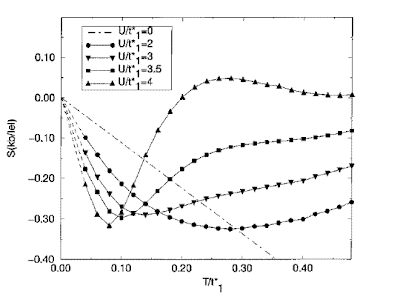How bad can it get?
Hearing some talks about properties of the metallic state of the iron pnictide superconductors underscored to me that one sees certain common features in a wide range of strongly correlated electron materials. These properties are distinctly different from electronic properties of elemental metals. These unusual properties arise from the fact that a low energy scale emerges which defines a temperature scale T0 (often in the range 10-100 K) above which quasi-particles do not exist and we have a bad metal. Signatures of this crossover from a Fermi liquid at low temperature to a bad metal are:
All of the above features in the transport are captured by a dynamical mean-field theory (DMFT) treatment of a range of lattice Hamiltonians such as the Hubbard model and Anderson lattice model. These issues are discussed in more detail in a paper Jaime Merino and I wrote 10 years ago. The figure below illustrates how sensistive the thermopower is to the destruction of quasi-particles.
 A recent paper by Haule and Kotliar considered the coherence-incoherence crossover in the pnictides using LDA-DMFT.
A recent paper by Haule and Kotliar considered the coherence-incoherence crossover in the pnictides using LDA-DMFT.
Relevant papers on the thermopower and Hall coefficient of the pnictides that I became aware of this week include those of David Mandrus' group and Paul Canfield's group.
- the resistivity, Hall coefficient, and thermopower can have a non-monotonic temperature dependence
- with increasing temperature the resistivity can smoothly increase to values much larger than the Mott-Ioffe-Regel limit (h2 a/e ~ 1 mohm-cm)
- at temperatures of order T0 the thermopower can reach values as large as kB/e ~ 50 microV/K
- above temperatures of order T0 the Drude peak in the frequency dependent conductivity collapses and the associated spectral weight shifts to higher frequencies
- most of the spectral weight in the frequency dependent conductivity is at high frequencies
All of the above features in the transport are captured by a dynamical mean-field theory (DMFT) treatment of a range of lattice Hamiltonians such as the Hubbard model and Anderson lattice model. These issues are discussed in more detail in a paper Jaime Merino and I wrote 10 years ago. The figure below illustrates how sensistive the thermopower is to the destruction of quasi-particles.
 A recent paper by Haule and Kotliar considered the coherence-incoherence crossover in the pnictides using LDA-DMFT.
A recent paper by Haule and Kotliar considered the coherence-incoherence crossover in the pnictides using LDA-DMFT.Relevant papers on the thermopower and Hall coefficient of the pnictides that I became aware of this week include those of David Mandrus' group and Paul Canfield's group.

Comments
Post a Comment